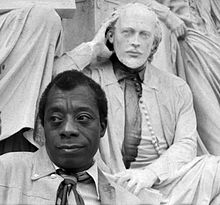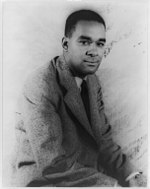I met James Baldwin 3 important times in
my life. The first time was through his writing when I read his books
"Go Tell It On The Mountain" and "Giovanni's Room". Both were explosive
books that talked about being gay openly, and sexually, explicitly at a
time it was talked about only in shadows. It was also a time I was
exploring my own sexuality and ceratinly helped me understand it more.
A
few years later when I was going with Paul Orr, a producer of the Jack
Paar TV show, he took me backstage of "Blues For Mr. Charlie", a play by
Baldwin, making its debut on Broadway. The last time was in 1969, just
before I was leaving to live in Memphis, when he was at a party I was
attending. He had just flown in from Paris, was very involved with the
civil rights movement and this was a fund raising party. Somehow I found
myself in a group consisting of Baldwin and Marlon Brando and about 6
other people. Though I was becoming an accomplished public speaker, was
33 and far from shy I stood there listening for 45 minutes without
saying a word!
Literary career
In 1953, Baldwin's first novel, Go Tell It on the
Mountain, an autobiographical bildungsroman, was published. Baldwin's first
collection of essays, Notes of a Native Son appeared two
years later. Baldwin continued to experiment with literary forms throughout his
career, publishing poetry and plays as well as the fiction and essays for which
he was known.
Baldwin's second novel, Giovanni's Room, stirred controversy when
it was first published in 1956 due to its explicit homoerotic content.[8] Baldwin was again
resisting labels with the publication of this work:[9] despite the
reading public's expectations that he would publish works dealing with the
African American experience, Giovanni's Room is exclusively about white
characters.[9] Baldwin's
next two novels, Another CountryTell Me How Long the
Train's Been Gone, are sprawling, experimental works[10] dealing with black and white characters and with heterosexual, homosexual, and
bisexual characters.[11] These novels
struggle to contain the turbulence of the 1960s: they are saturated with a sense
of violent unrest and outrage. and
Baldwin's lengthy essay Down
at the Cross (frequently called The Fire Next Time after the title of
the book in which it was published)[12] similarly showed
the seething discontent of the 1960s in novel form. The essay was originally
published in two oversized issues of The New Yorker and landed Baldwin on the
cover of Time magazine in 1963 while Baldwin was touring the South speaking about the restive
Civil Rights movement. The essay talked about the uneasy relationship between
Christianity and the burgeoning Black Muslim movement. Baldwin's next
book-length essay, No Name in the Street, also discussed
his own experience in the context of the later 1960s, specifically the
assassinations of three of his personal friends: Medgar Evers, Malcolm X, and Martin Luther King,
Jr.
Baldwin's writings of the 1970s and 1980s have been largely overlooked by
critics. The assassinations of black leaders in the 1960s, Eldridge Cleaver's
vicious homophobic attack on Baldwin in Soul on Ice, and Baldwin's return
to southern France contributed to the sense that he was not in touch with his
readership. Always true to his own convictions rather than to the tastes of
others, Baldwin continued to write what he wanted to write. His two novels
written in the 1970s, If Beale Street Could Talk and
Just Above My
Head, placed a strong emphasis on the importance of black families, and
he concluded his career by publishing a volume of poetry, Sonny's Blues, as
well as another book-length essay, The Evidence of Things Not
Seen, which was an extended meditation inspired by the Atlanta Child Murders of the early 1980s.
Baldwin's
expatriation
During his teenage years in Harlem and Greenwich Village, Baldwin began to
recognize his own homosexuality. In 1948, disillusioned by American prejudice
against blacks and homosexuals, Baldwin left the United States and departed to
Paris, France. His flight was not just a
desire to distance himself from American prejudice. He fled in order to see
himself and his writing beyond an African American context and to be read as not
"merely a Negro; or, even, merely a Negro writer" Also, he left the United States desiring to come to terms with his sexual
ambivalence and flee the hopelessness that many young African American men like
himself succumbed to in New York.
In Paris, Baldwin was soon involved in the cultural radicalism of the Left
Bank. His work started to be published in literary anthologies, notably
Zero , which was edited by
his friend Themistocles Hoetis and which had already
published essays by Richard Wright.
He would live as an expatriate in France for most of his later life. He
would also spend some time in Switzerland and Turkey. During his life and after it, Baldwin would be seen not only as an influential
African American writer but also as an influential exile writer, particularly
because of his numerous experiences outside of the United States and the impact
of these experiences on Baldwin's life and his writing.
Social and political
activism
After his return to the United States from France and a subsequent trip to
the South in 1962, Baldwin aligned himself more closely with the ideals of the
Congress of Racial Equality (CORE)
and the Student Nonviolent
Coordinating Committee (SNCC). In 1963 he conducted a lecture tour of the
South for CORE, traveling to locations like Durham and Greensboro, North
Carolina and New Orleans, Louisiana. During the tour, he lectured to students,
white liberals, and anyone else listening about his racial ideology, an
ideological position between the "muscular approach" of Malcolm X and the nonviolent program of Martin Luther King Jr..
At this time, Baldwin threw himself into the civil rights movement. In 1963,
along with prominent figures like Lorraine Hansberry and Harry Belafonte and
other civil rights figures, Baldwin met with then Attorney General Robert F. Kennedy to discuss the moral implications of the civil rights movement. Although most of
the attendees of this meeting left feeling "devastated," the meeting was an
important one in voicing the concerns of the civil rights movement and it
provided exposure of the civil rights issue not just as a political issue but
also as a moral issue.. Baldwin also made
a prominent appearance at the Civil Rights March on
Washington, D.C. on August 28th, 1963, also with Belafonte, as well as with
long time friends Sidney
Poitier and Marlon
Brando.
Inspiration and
relationships
Inspiration and
relationships
One source of support came from an admired older writer Richard
Wright, whom he called "the greatest black writer in the world". Wright and
Baldwin became friends for a short time and Wright helped him to secure the
Eugene F. Saxon Memorial Award. Baldwin titled a collection of essays
Notes of
a Native Son, in clear reference to Wright's novel Native Son. However,
Baldwin's 1949 essay "Everybody's Protest Novel" ended the two authors'
friendship[15]Native Son, like Harriet Beecher
Stowe's Uncle Tom's Cabin, lacked credible
characters and psychological complexity. However, during an interview with
Julius Lester,[16] because Baldwin
asserted that Wright's novel Baldwin explained
that his adoration for Wright remained: "I knew Richard and I loved him. I was
not attacking him; I was trying to clarify something for myself".
1949 was also the year he met and fell in love with Lucien
Happersberger. The boy was a seventeen-year-old runaway, and the two became
very close, until Happersberger's marriage three years later, an event that left
Baldwin devastated.[17]
Another major influence on Baldwin's life was the African-AmericanBeauford
Delaney. In The Price of the Ticket (1985),
Baldwin describes Delaney as "the first living proof, for me, that a black man
could be an artist. In a warmer time, a less blasphemous place, he wou painter
became, for me, an example
of courage and integrity, humility and passion. An absolute integrity: I saw him
shaken many times and I lived to see him broken but I never saw him bow".
Baldwin was a close friend of the singer, pianist and civil rights activist
Nina Simone. Together with
Langston Hughes and
Lorraine
Hansberry, Baldwin was responsible for making Simone aware of the civil
rights movement that was forming at that time to fight racial inequality. He
also provided her with literary references that influenced her later work.
Baldwin also had an influence on the work of the French painter Philippe Derome who he
met in Paris at the beginning of the 1960s.
Maya Angelou called
Baldwin her "friend and brother", and credited him for "setting the stage" for
the writing of her 1969 autobiography, I Know Why the Caged Bird
Sings.












There is a couple there I liked to read if I can find it.
Tell it on the Mountain and One Day When I Was lost.
Matter of fact will check with the library but believed that they will have none of his books in this town.But nonetheless they will find it for me and are good in doing so.Thank you for the article.